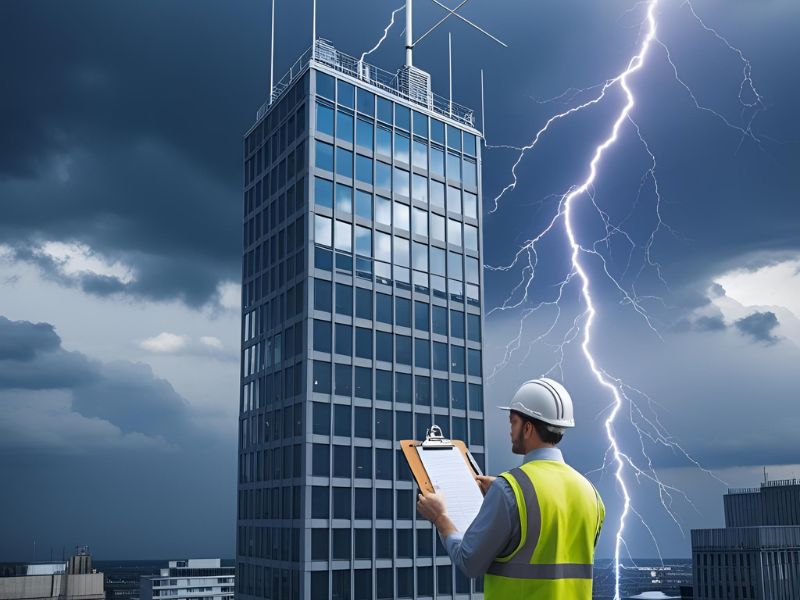
When you look up at a tall building, you might wonder: at what height does a building require lightning protection? The answer isn't as simple as you might think. In the UK, there's no magic number written in law that suddenly makes lightning protection mandatory at a certain height.
Instead, the decision comes down to a proper risk assessment following BS EN 62305 standards. This approach makes sense when you consider that a relatively low building in an exposed location might need protection more than a taller building surrounded by other structures.
Building height plays a crucial role in determining lightning strike risk. According to IEC data, a 50m building is 8-10 times more likely to be struck than a 10m building in the same location. This happens because tall structures act as lightning attractors - the taller the building, the larger its collection area for lightning strikes.
The physics behind this is straightforward. Lightning seeks the easiest path to ground, and taller buildings provide a shorter route for electrical energy to travel. This is why you'll always see lightning rods on skyscrapers like the Burj Khalifa, which stands 828m tall and gets equipped with multiple lightning protection systems designed to handle direct strikes up to 200kA.
Even the Empire State Building demonstrates this principle. At 381m tall, it gets hit by lightning about 25 times a year. These real-world examples show that above certain heights, lightning protection isn't optional - it becomes essential for building safety and operational continuity.

The current BS EN 62305 standard revolutionized how we determine lightning protection needs. For those wondering what is BS EN 62305, it's the comprehensive British and European standard that replaced the older, more simplistic approach to lightning protection. Unlike older systems that relied on simple height rules, this comprehensive approach considers multiple risk factors.
Under the previous BS 6651 standard, engineers used basic guidelines where buildings up to 20m could rely on simple 45-degree protection zones from lightning rods. For buildings over 20m, they had to use the rolling sphere method to calculate exposed areas. While this height-based thinking influenced perception for years, modern standards take a more sophisticated approach.
BS EN 62305 requires a thorough risk assessment that examines factors beyond just height. The standard looks at geographical location, surrounding terrain, building contents, and the consequences of a lightning strike. This means a 15m building housing sensitive electronic systems in an exposed rural location might need protection, while a 25m building in a dense urban area with less sensitive contents might not.
The standard divides buildings requiring lightning protection into different protection levels, from LPL I (highest protection) to LPL IV (basic protection). Each level determines the design parameters for air termination systems, down conductors, and earthing systems.
When determining lightning protection needs, several critical factors work alongside building height. Location plays a massive role - buildings in areas with high thunderstorm activity face greater risk than those in regions with fewer storms per year.
The type of structure and its contents significantly influence protection requirements. Buildings housing sensitive equipment like data centers, hospitals, or manufacturing facilities with electronic control systems typically need protection regardless of height. The potential consequences of lightning damage drive many protection decisions.
Surrounding terrain affects risk assessment. An isolated building on a hilltop faces much higher risk than the same building surrounded by taller structures in an urban setting. Trees, other buildings, and geographical features all influence how attractive a building becomes to lightning strikes.
The building's construction materials also matter. Steel-framed buildings naturally conduct electrical energy better than wood-framed structures, which affects both risk and protection system design. Similarly, buildings with metal roofing or extensive metal components may require different protection approaches.
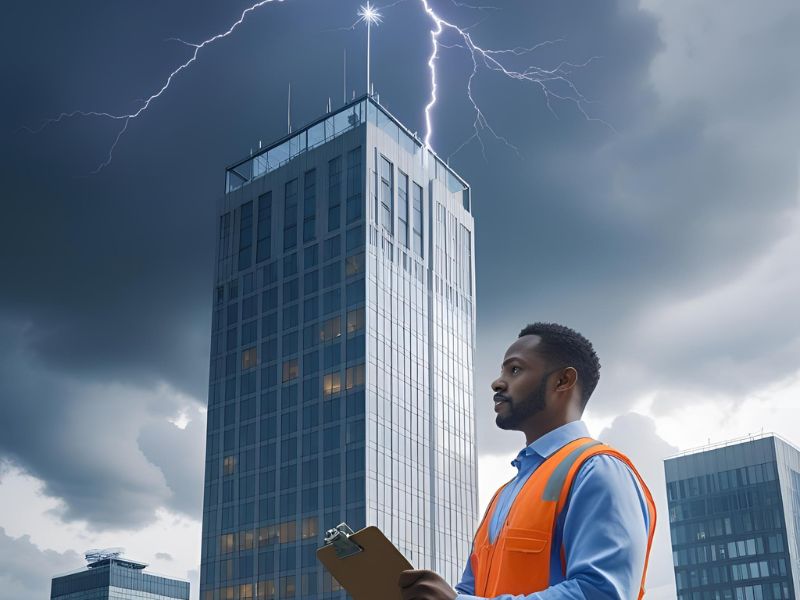
The evolution from height-based rules to risk assessment represents a significant improvement in lightning protection methodology. The older BS 6651 standard provided simple guidelines that many people still remember, creating the misconception that specific heights automatically trigger protection requirements.
Under BS 6651, the 20m threshold became deeply embedded in industry thinking. Buildings below this height could use straightforward protection designs, while taller structures required more complex calculations. This created an unofficial height requirement that many still believe exists today.
Modern approaches recognize that height alone doesn't determine lightning protection needs. A thorough risk assessment provides much better guidance for protecting both property and people. This shift acknowledges that lightning protection depends on multiple interacting factors rather than a single measurement.
The change also reflects improved understanding of lightning behavior and more sophisticated protection technologies. Today's air termination systems, surge protection devices, and grounding systems offer more precise protection tailored to specific building characteristics and risk profiles.
While no legal requirement exists at specific heights, engineering practice has developed useful guidelines for buildings at different elevations. These recommendations help engineers design appropriate protection systems based on decades of experience and scientific research.
For buildings over 30m, engineers typically consider additional equipotential bonding to manage potential differences during lightning strikes. The increased height creates larger voltage differences that require careful management to prevent dangerous conditions.
Buildings exceeding 60m often receive enhanced side-flash protection covering at least 20% of the structure. At these heights, lightning can strike the sides of buildings rather than just the top, requiring protection systems that address multiple strike points.
Structures over 120m require advanced multi-level protection systems to address extreme strike risk and side-flash hazards. These buildings face such significant lightning exposure that comprehensive protection becomes essential for safety and operational continuity.
These guidelines reflect practical engineering experience rather than regulatory requirements. They help engineers design effective protection systems while avoiding both under-protection and unnecessary over-design.
Commercial buildings often face different lightning protection considerations than residential properties. The higher value of commercial equipment, greater number of occupants, and business continuity requirements typically justify more comprehensive protection systems.
Large commercial buildings frequently house expensive electronic systems that lightning can easily damage. Manufacturing equipment, computer networks, telecommunications systems, and building automation systems all represent significant investments that lightning protection helps preserve.
Commercial properties also face regulatory requirements that residential properties might not encounter. Buildings housing sensitive equipment or serving critical functions may need lightning protection to meet insurance requirements or industry standards.
Residential properties still need lightning protection in many circumstances, but the decision criteria often differ. Large residential buildings, especially those in exposed locations or with valuable electronic systems, benefit from proper lightning protection systems.
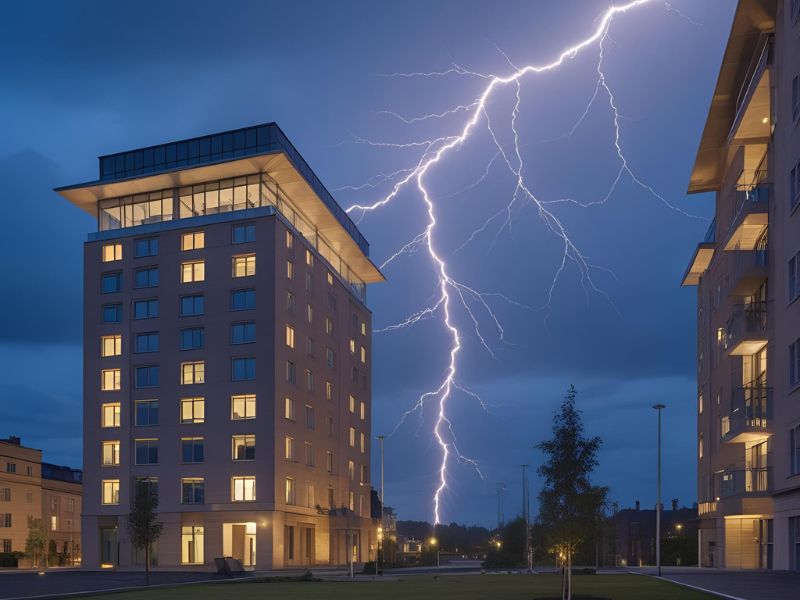
Geographic location significantly influences lightning protection requirements. The UK experiences varying levels of thunderstorm activity, with some regions seeing much higher lightning flash density than others.
Coastal areas often experience different lightning patterns than inland regions. Hills, valleys, and other geographical features create local weather patterns that affect lightning risk. Buildings in these exposed locations may need protection regardless of their height compared to structures in more sheltered areas.
Urban environments provide some natural lightning protection through the presence of taller buildings and extensive metal infrastructure. Rural locations, especially elevated or isolated sites, face much higher lightning risk for buildings of any height.
Weather patterns continue changing, with some experts noting increased thunderstorm activity in certain regions. This makes ongoing risk assessment important for existing buildings and critical for new construction projects.
Effective lightning protection systems contain several interconnected components that work together to safely manage lightning energy. The air termination system intercepts lightning strikes and provides the initial path for electrical energy.
Air terminals, commonly called lightning rods, must be positioned to protect the entire structure. Modern systems use sophisticated calculations to determine optimal placement rather than relying on simple rules of thumb. The goal is ensuring no part of the building remains exposed to direct lightning strikes.
Down conductors carry lightning energy from air terminals to the grounding system. These conductors must be sized appropriately for the expected electrical energy and installed to avoid creating dangerous voltage differences within the building structure.
The earthing system safely dissipates lightning energy into the ground. This component often represents the most critical part of the entire protection system. Poor earthing can render even the best air termination system ineffective and create dangerous conditions.
Surge protection devices protect electronic systems from indirect lightning effects. Even with proper external protection, electromagnetic pulses from nearby strikes can damage sensitive equipment. Internal surge protection provides this additional layer of defense.
Lightning protection systems require regular testing and maintenance to ensure continued effectiveness. For those wondering how often should lightning protection be tested, Lightning Protection Testing UK specializes in these critical services that keep protection systems functioning properly.
Visual inspection forms the foundation of effective maintenance programs. Trained technicians examine air terminals, down conductors, and earthing connections for signs of damage, corrosion, or loosening. Weather, age, and building modifications can all affect system integrity.
Earth resistance testing verifies that grounding systems maintain proper electrical characteristics. Soil conditions change over time, and connections can deteriorate, reducing the system's ability to safely dissipate lightning energy. Regular testing identifies these issues before they compromise protection.
Continuity testing ensures electrical connections throughout the system remain intact. Lightning strikes, building vibrations, and thermal expansion can create breaks in protection circuits that testing reveals and maintenance can correct.
Professional testing also verifies that building modifications haven't compromised protection coverage. New equipment, additions, or changes to building systems may require protection system updates to maintain comprehensive coverage.
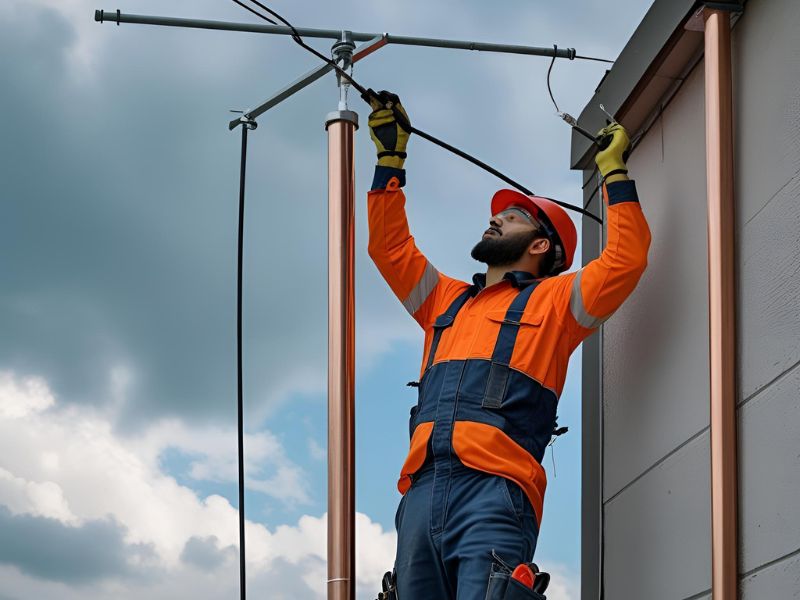
Lightning protection system costs vary significantly based on building characteristics, protection requirements, and local conditions. For those asking how much does lightning protection installation cost in the UK, it's important to understand that these costs typically represent a small fraction of potential lightning damage expenses.
Direct lightning strikes can cause extensive structural damage, fires, and destruction of electronic systems. The Empire State Building's experience with 25 lightning strikes per year demonstrates how frequently tall buildings face this risk. Without proper protection, each strike could cause devastating damage.
Indirect lightning effects often prove even more costly than direct strikes. Power surges from nearby lightning can destroy computers, telecommunications equipment, HVAC systems, and other building systems throughout the structure. These losses often exceed the cost of comprehensive protection systems.
Business interruption costs frequently represent the largest lightning-related expenses. Manufacturing downtime, data loss, and operational disruptions can cost far more than repairing physical damage. Effective protection systems prevent these costly interruptions.
Insurance companies increasingly recognize lightning protection value and may offer reduced premiums for properly protected buildings. Some policies require protection systems for certain building types or locations, making protection a practical necessity rather than an option.
While no specific height triggers mandatory lightning protection in UK law, various regulations and standards influence protection decisions. For those asking is lightning protection a legal requirement in the UK, the answer depends on how these overlapping obligations apply to a given building. Building regulations, health and safety requirements, and industry standards all play roles in determining protection needs.
The Construction (Design and Management) Regulations require consideration of lightning risk during building design and construction. This creates a legal requirement to assess lightning hazards and implement appropriate protection measures when necessary.
Health and Safety at Work Act obligations extend to lightning protection in many circumstances. Employers must protect workers from lightning hazards, which may require protection systems regardless of specific height thresholds.
Industry-specific regulations may mandate lightning protection for certain building types. Aviation facilities, explosive storage buildings, and other specialized structures face specific requirements that often exceed general building standards.
Insurance requirements frequently drive protection decisions even when legal mandates don't exist. Many insurance policies require lightning protection assessments and may mandate systems for coverage to remain valid.
Lightning protection technology continues advancing with new materials, improved design methods, and better understanding of lightning behavior. These developments improve protection effectiveness while reducing installation and maintenance costs.
Advanced lightning detection systems now provide early warning of approaching storms, allowing building operators to take protective measures. These systems complement physical protection by enabling proactive responses to lightning threats.
Smart building integration allows lightning protection systems to communicate with building management systems. This integration enables automatic responses to lightning events and continuous monitoring of protection system status.
Improved surge protection devices offer better protection for increasingly sensitive electronic systems. As buildings incorporate more sophisticated technology, protection systems must evolve to address new vulnerabilities.
Research into lightning behavior continues revealing new insights that improve protection system design. Better understanding of side flashes, multiple strokes, and electromagnetic effects leads to more effective protection strategies.
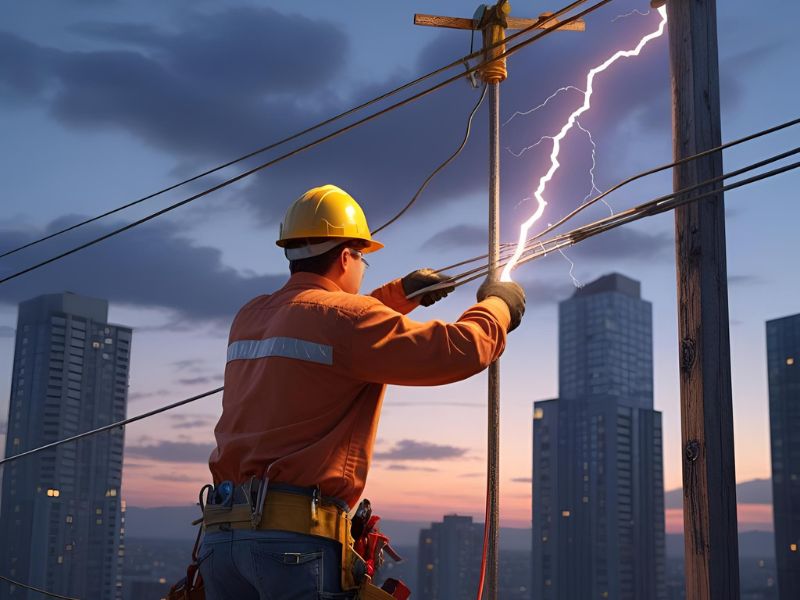
Determining whether your building needs lightning protection requires careful consideration of multiple factors beyond simple height measurements. Professional risk assessment provides the most reliable guidance for making this important decision.
Start by evaluating your building's characteristics: height, location, contents, and usage patterns. Consider the potential consequences of lightning damage to both property and operations. Buildings housing critical systems or serving essential functions typically justify protection regardless of height.
Consult with qualified lightning protection professionals who can perform comprehensive risk assessments. These assessments consider all relevant factors and provide specific recommendations based on current standards and best practices.
Consider future building changes and technology upgrades that might affect lightning protection needs. Protection systems installed during initial construction typically cost less than retrofit installations and provide better integration with building systems.
Don't wait for lightning to strike before addressing protection needs. The time to implement lightning protection is before storm season arrives, not after experiencing lightning damage.
Understanding whether your building requires lightning protection involves more than measuring its height. The complex interplay of building characteristics, location factors, and risk considerations requires professional evaluation to ensure appropriate protection decisions.
As a leading lightning protection company, Lightning Protection Testing UK provides comprehensive risk assessments that follow BS EN 62305 standards and consider all relevant factors affecting your building's lightning protection needs. Our experienced team evaluates everything from building height and location to contents and usage patterns.
We offer complete lightning protection services including system design, installation, testing, and ongoing maintenance. Our thorough approach ensures your building receives appropriate protection based on actual risk rather than outdated rules of thumb.
Don't leave your building's lightning protection to chance or rely on obsolete height-based guidelines. Contact Lightning Protection Testing UK today for a professional assessment that provides definitive answers about your building's lightning protection requirements and helps protect your property investment.